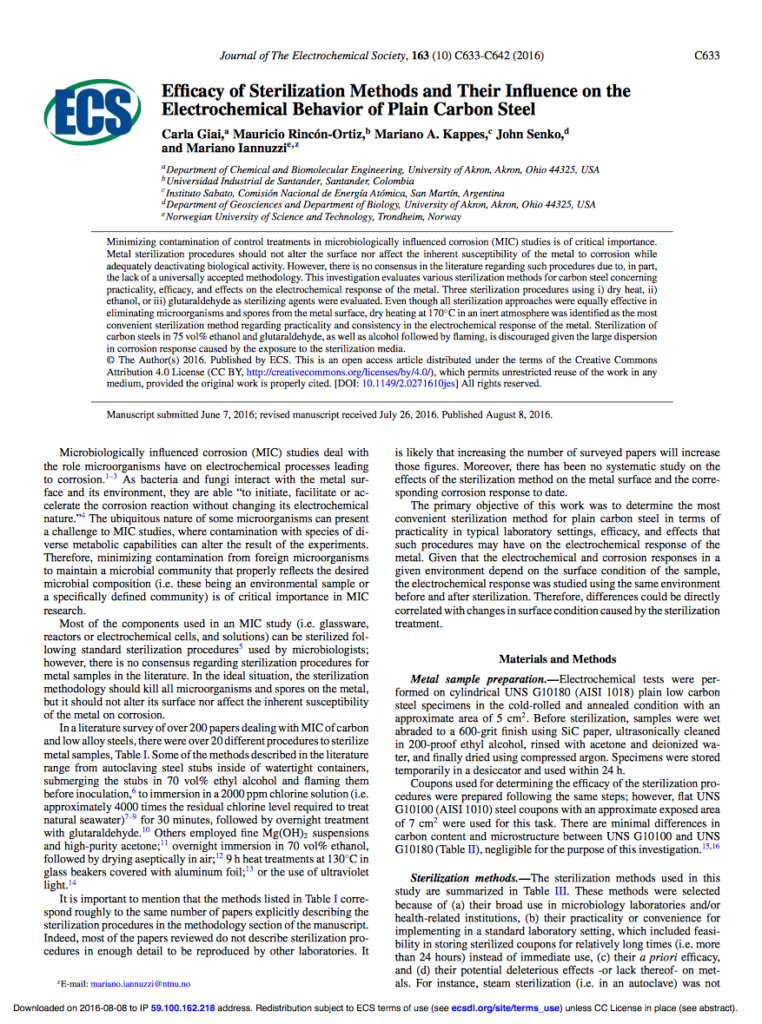Together with Dr. Carla Giai, Dr. Mariano A. Kappes, Prof. Mauricio Rincón-Ortiz, and Prof. John Senko, we have recently published a new peer-reviewed article on the efficacy of sterilization methods and their influence on the corrosion response of carbon steel.
Sample sterilization is a crucial step in microbially induced corrosion (MIC) research that researchers usually overlook. Metal sterilization procedures should not alter the surface nor affect the inherent susceptibility of the metal to corrosion, while adequately deactivating biological activity.
In this article, we recommend a test methodology to evaluate other sterilization procedures not covered by our investigation. Likewise, we would like to ignite debate in the MIC community about the possibility of standardizing sample sterilization approaches.
So, are all sterilization methods the same? Do they alter the corrosion response of the sample being investigated?
To find out, go ahead, and get a copy of the manuscript!
The article has ben published as OpenAccess, distributed under the terms of the Creative Commons Attribution License, which permits unrestricted use, distribution, and reproduction in any medium, provided the original author and source are credited. You can download it from the Journal of the Electrochemical Society website or by clicking on the image below.
Abstract
Minimizing contamination of control treatments in microbiologically influenced corrosion (MIC) studies is of critical importance. Metal sterilization procedures should not alter the surface nor affect the inherent susceptibility of the metal to corrosion while adequately deactivating biological activity. However, there is no consensus in the literature regarding such procedures due to, in part, the lack of a universally accepted methodology. This investigation evaluates various sterilization methods for carbon steel concerning practicality, efficacy, and effects on the electrochemical response of the metal. Three sterilization procedures using i) dry heat, ii) ethanol, or iii) glutaraldehyde as sterilizing agents were evaluated. Even though all sterilization approaches were equally effective in eliminating microorganisms and spores from the metal surface, dry heating at 170°C in an inert atmosphere was identified as the most convenient sterilization method regarding practicality and consistency in the electrochemical response of the metal. Sterilization of carbon steels in 75 vol% ethanol and glutaraldehyde, as well as alcohol followed by flaming, is discouraged given the large dispersion in corrosion response caused by the exposure to the sterilization media.
Citation
Giai, C., Rincón-Ortíz, M., Kappes, M. A., Senko, J. & Iannuzzi, M. Efficacy of Sterilization Methods and Their Influence on the Electrochemical Behavior of Plain Carbon Steel. Journal of The Electrochemical Society 163, C633-C642, doi: 10.1149/2.0271610jes (2016).

[altmetric doi=”10.1149/2.0271610jes” type=”donut” condensed=”true” data-hide-no-mentions=”false” popover=”right” details=”right”]
Update February 5, 2017
Added the Altmetric badge, Abstract, citation information, and Kudos description.